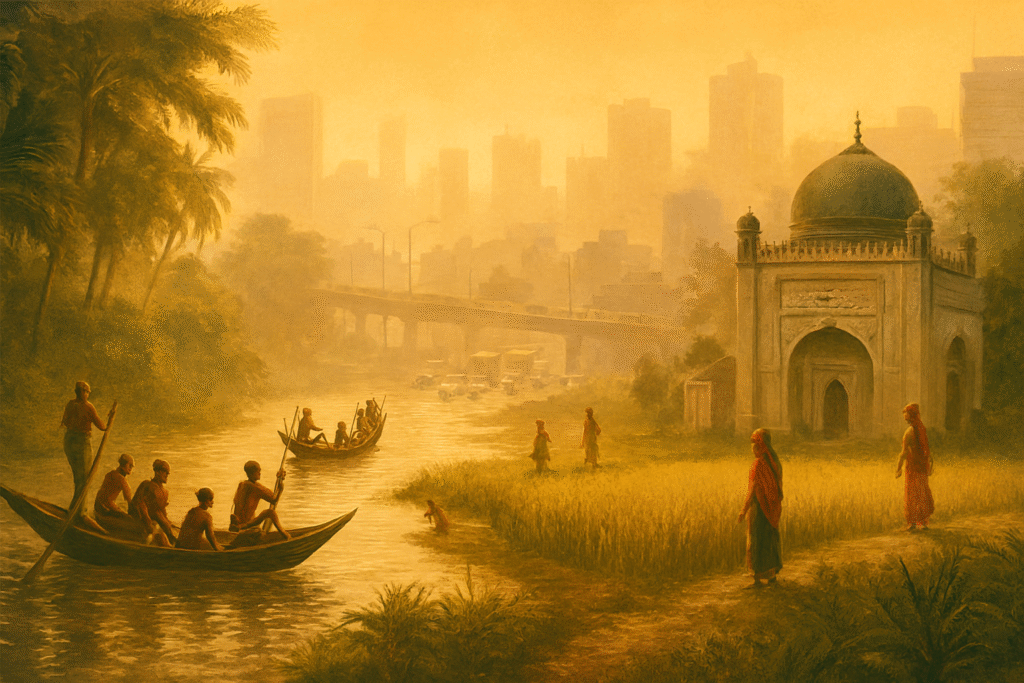Maghs of Moghbazar: From River Raiders to Urban Legacy
In the bustling urban heart of Dhaka lies Moghbazar, a place whose modern high-rises and traffic-choked avenues conceal a far older story. The area’s name itself hints at that past: “Moghbazar” refers to the settlement of the Maghs of Arakan, a river-borne community whose arrival, settlement and legacy left an imprint on the neighbourhood’s identity. This article explores the narrative of the Maghs of Moghbazar and how they came, how they settled, and how their descendants live on in one of Bangladesh’s busiest locales.
Who Were the Maghs?
The term “Magh” is applied historically to groups associated with the Arakan region (present-day Rakhine State of Myanmar) and with maritime raids in Bengal’s waterways.
They were prominent in the 17th century for river-borne raids through the Buriganga, Shitalakhya and Meghna rivers, targeting villages and river settlements around Dhaka.
Because of these raids, certain places acquired fearsome reputations — the Bengali proverb “Magher mulluk” (land of the Maghs) emerged in reference to lawless lands.
Arrival and Settlement in Moghbazar
In the early 1600s, as the Mughals consolidated power in Bengal and Dhaka grew in importance, the Maghs’ movements brought them closer to the emerging city. Around 1620, the Mughals defeated a Magh fleet of around 4,000 boats; some Magh leaders then surrendered and sought settlement.
One significant episode: Mukut Ray, nephew of the Magh king and governor of Chittagong, surrendered in the 1630–35 CE period and converted to Islam with his followers. They were resettled on the banks of the Pandu River, north of Dhaka.
Over time the region that became Moghbazar (covering present-day areas like Nayatola, Madhubagh, Mirbagh, Eskaton, Siddheshwari) developed from forested land and riverbank settlement into part of Dhaka’s urban fabric.
Community, Land & Legacy
What did life look like for the Maghs of Moghbazar? Although once feared as raiders, many settled Maghs became cultivators, land-holders and community figures once assimilated in the Dhaka suburbs. For example, family trees still exist claiming descent from the original Magh settlers (e.g., the Sardar family of Moghbazar, the Sheikh Dilu family of Dilu Road, Ali Bakhsh’s family of Madhubagh).
Naming of Moghbazar & Changing Urban Landscape
The name “Moghbazar” is directly tied to the Maghs: the community once settled there, and the marketplace and settlement took their name.
Historically, the Pandu River flowed through what is now Basabo, Khilgaon and Madartek, and the Magh settlement sat along its banks. Over centuries, the waterways receded, forests were cleared, and the land urbanised. A 1993 book by historian Muntasir Mamun noted that as recently as about 120 years ago Moghbazar was still thick forest.
Today Moghbazar is one of Dhaka’s busiest commercial-residential zones. The layers of history remain hidden beneath concrete, fly-overs and shopping malls.
Though large parts of their material legacy have vanished, vestiges remain. One site was the community mosque built after the conversion of Magh leaders, reportedly located between Siddheshwari and Moghbazar (near present Ramna Police Station). The inscription in Persian above its door survives in memory.
The Sardar family of Moghbazar, descendants of Maghs, once had a garden house, ponds and cultivated land where now stands large shopping complexes. The present-day Sardar family member recounts the original settings of “rice growing, fish ponds, mango and jackfruit trees” in what is now intensely urban.
Why the Story of the Maghs Matters Globally
Migration, Settlement & Assimilation
The story of the Maghs of Moghbazar reflects broad themes of migration, conquest, resettlement and assimilation — often seen in cities around the world. A community that arrived by force, later settled, assimilated and gradually transformed from hostile raiders to settled land-holders.
Urban Evolution
Moghbazar shows how an area evolves: from riverbank forest to settlement to dense urban zone. The pattern mirrors major cities globally where waterways shift, land-use changes, and communities get folded into mega-cities.
Heritage & Identity
For descendants, maintaining awareness of heritage amid urban change is a global challenge. Many world-cities contain buried stories of former communities whose names, streets or monuments testify to vanished pasts.
Present-Day Challenges and Opportunities
While some families still claim Magh descent, they face the pressures of modern urban life: land-loss, fragmentation, lack of formal recognition, and disappearance of community memory.
Preserving the Legacy: What Can Be Done?
Oral-History Initiatives: Recording stories of descendants can preserve knowledge that might otherwise vanish.
Heritage Markers/Signage: At sites like the old mosque or garden-house locations, plaques or walking tours can highlight the Magh heritage in Moghbazar.
Academic Research & Documentation: More deep-dive studies into land records, settlement patterns and community evolution would illuminate this history further.
Urban-Planning Integration: As Dhaka continues to expand, integrating heritage conservation into development (instead of erasing it) can create more layered, meaningful city spaces.
Conclusion
The Maghs of Moghbazar may not dominate headlines, but their story is deeply embedded in Dhaka’s history — a tale of river raids and resettlement, of land and community, and of urban transformation. From the waterways of the 17th century to today’s high-rise skyline, the Maghs of Moghbazar remind us of the hidden layers beneath modern cities. For Dhaka, and for global readers interested in migration, urbanisation and heritage, their legacy offers both insight and inspiration.
